
If you ride a bike, chances are, you'd rather be in the saddle on the open road rather than in front of a squat rack in the weight room.
"Most cyclists tend to singularly embrace... the notion that if you want to be a better cyclist, you need to do one thing a lot — cycle," says Trapper Steinle, USA Cycling coach, former professional XC mountain bike racer, personal trainer and endurance coach at Life Time Cherry Creek in Colorado.
Video of the Day
Video of the Day
But if you want to ride longer and stronger, you'll need to switch up your strategy by introducing resistance training into your weekly routine.
Check out more of our 20-minute workouts here — we’ve got something for everyone.
Why Cyclists Should Do Strength Training
Without a cross-training element, cycling limits you to developing movements in only one plane: moving front to back, Steinle says. "This means that the body is being highly trained in a very limited pattern that doesn't promote lateral or rotational movement."
The problem with this type of one-dimensional approach is that it typically leads to postural imbalances and, in worst-case scenarios, chronic pain and injury.
"Cyclists tend to get very tight in the areas responsible for flexion of the hips, knees and ankles," Steinle says. This restricts your ability to effectively recruit the muscles you need for speed and power in the saddle as well as a better quality of life off the bike.
"Supplementing your cycling with a periodized cross-training program that focuses on core strength, lateral and rotational movements, along with explosive, maximal strength exercises is the answer to your woes," Steinle says.
In other words, not only will weight training help prevent muscle imbalances, pain and potential injury, it can also substantially boost your speed and power on the bike.
Try This 20-Minute Strength-Training Workout for Cyclists
Ready to see your riding buddies shrink out of sight over your shoulder? Designed by Steinle for the time-crunched cyclist, this 20-minute, circuit-style strength routine will give you a surge in speed, improve your stamina and blast body fat.
Tip
“In order to continue developing and progressing, you must constantly overload the body through increased challenge of stimulus,” says Steinle, who recommends gradually upping your weights after 3 to 5 weeks of doing this workout regularly.
Warm-Up
Do: 8 to 10 minutes of light cardio on a rower, bike or stair mill, increasing the intensity every few minutes, followed by hip and shoulder mobility stretches.
The Main Workout
Do: all exercises in Circuit 1, repeating for a total of 4 sets. Then move to Circuit 2 and follow the same structure. This workout should be completed with little to no rest.
Circuit 1
Move 1: Dumbbell Front Squat
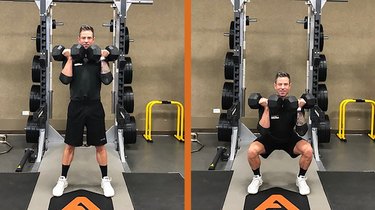
- Hold either one dumbbell close to your chest in front of the body or two dumbbells (one in each hand) held at your shoulders.
- Engage your core, hinge your hips back and bend your knees to lower into a squat, trying to get your thighs parallel to the floor.
- Push through your heels, returning to standing. Focus on driving the hips forward as you stand.
Move 2: Box Jump
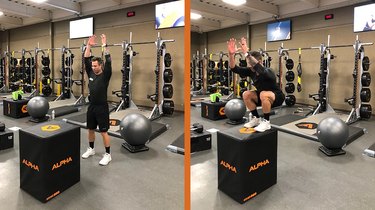
- Stand a few inches in front of a box.
- Swing your arms back behind you as you squat and load your legs before exploding upward to jump onto the box, landing softly with knees bent.
- Stand, then step down one foot at a time.
Move 3: Plank Walkout
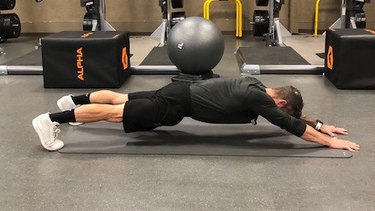
- Begin in a high plank with your hands beneath your shoulders and your body in a straight line from head to hips to heels.
- Walk your hands out in front of you as far as you can go, keeping your core engaged.
- Pause before walking them back to a high plank.
Move 4: Resistance Band Rotation
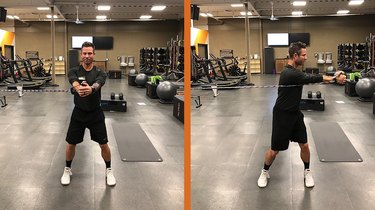
- Stand to the side of a cable machine (or a resistance band anchored at chest height).
- Grasp the handle with your arms straight in front of you and elbows locked out, creating a triangle between your arms and chest. This is the starting position.
- Engage your core and rotate your torso up to 90 degrees in the opposite direction as the anchor point, keeping your feet and hips square to the front.
- Then in a slow, controlled movement, rotate back to the starting position.
- Do 6 reps on each side.
Circuit 2
Move 1: Barbell Deadlift

- Hinging at your hips, lean forward and grasp a barbell (or a dumbbell in each hand) wider than shoulder width, maintaining a neutral spine.
- Drive your feet into the floor, lifting the bar as you squeeze your glutes and hamstring.
- Force your hips forward to align vertically with your body as you come to standing.
Move 2: Weighted Single-Leg Deadlift

- Holding a dumbbell in each hand, balance on one leg.
- While keeping a slight bend in your standing-leg knee, raise your other leg straight behind you as you hinge at the hips to bring your torso parallel to the floor (and lower the weight toward the floor). Think of moving your body in a seesaw motion: You hinge at the same rate that you lift the leg behind you.
- Your hips should stay level throughout the entire movement, avoiding the tendency to turn them out.
- Keep your back flat. At the bottom of the movement, your torso and raised leg should be almost parallel to the floor with the weight a few inches off the ground.
- Keeping your core tight, push through your heel to stand up straight, squeezing your glute and hamstring muscles as you return to standing.
- Do 6 reps on each leg.
Move 3: Anti-Rotation Dumbbell Row
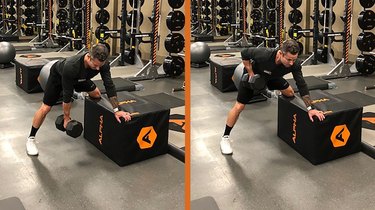
- Kneel on a bench with just your left knee, placing your left hand on the bench for support. Your other foot will be on the ground. Hold a dumbbell in your free hand and let it hang straight down.
- In this bent-over position, your chest should almost be parallel to the floor and you should maintain a flat back.
- Squeeze your shoulder blades together and brace your core as you draw the dumbbell up to the side of your chest.
- Slowly lower the weight back down.
- Do 8 reps on each side.
Move 4: Single-Leg Pendulum Swing
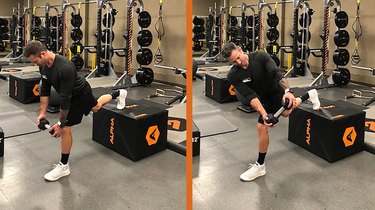
- Begin in a split-squat position with one foot in front of the other and slightly to the side. Your back foot should rest on a box and your front knee should be aligned with your ankle.
- Holding a dumbbell, hinge forward at the hip with a neutral spine.
- While engaging your core and maintaining balance on the stable leg, rotate side to side in a controlled movement, like a pendulum.
- Slowly rotate back to the center.
- Do 4 reps on each side.